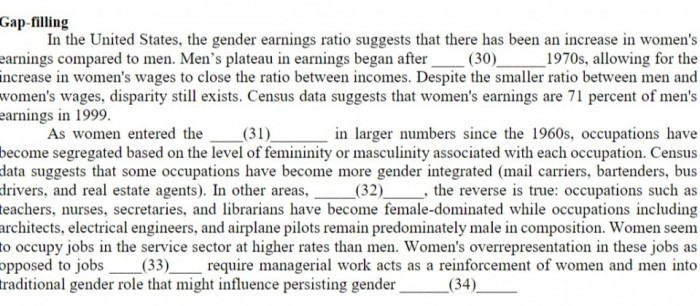
Bằng cách nhấp vào Đăng nhập, bạn đồng ý Chính sách bảo mật và Điều khoản sử dụng của chúng tôi. Nếu đây không phải máy tính của bạn, để đảm bảo an toàn, hãy sử dụng Cửa sổ riêng tư (Tab ẩn danh) để đăng nhập (New Private Window / New Incognito Window).
In the United States, the gender earnings ratio suggests that there has been an increase in women's earnings (1) compared to men. Men’s plateau in earnings began after the 1970s, allowing for the increase in women's wages to close the ratio between (2) incomes. Despite the smaller ratio between men and women's wages, disparity still exists. Census data suggests that women's earnings are 71 percent of men's (3) earnings in 1999.
As women entered the (4) workforce in larger numbers since the 1960s, occupations have become segregated based on the level of femininity or masculinity associated with each (5) occupation. Census data suggests that some occupations have become more gender integrated (mail carriers, (6) bartenders, bus drivers, and real estate agents). In other areas, however, the reverse is true: occupations such as teachers, nurses, secretaries, and librarians have become female-dominated while occupations including architects, electrical engineers, and airplane pilots remain predominately male in composition. Women seem to occupy jobs in the (7) service sector at higher rates than men. Women's overrepresentation in these jobs as opposed to jobs that require managerial work acts as a (8) reinforcement of women and men into traditional (9) gender roles that might influence persisting gender (10) inequality.

| Tham gia Cộng đồng Lazi trên các mạng xã hội | |
| Fanpage: | https://www.fb.com/lazi.vn |
| Group: | https://www.fb.com/groups/lazi.vn |
| Kênh FB: | https://m.me/j/AbY8WMG2VhCvgIcB |
| LaziGo: | https://go.lazi.vn/join/lazigo |
| Discord: | https://discord.gg/4vkBe6wJuU |
| Youtube: | https://www.youtube.com/@lazi-vn |
| Tiktok: | https://www.tiktok.com/@lazi.vn |
Hôm nay bạn thế nào? Hãy nhấp vào một lựa chọn, nếu may mắn bạn sẽ được tặng 50.000 xu từ Lazi
| Vui | Buồn | Bình thường |